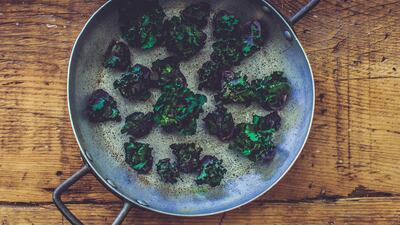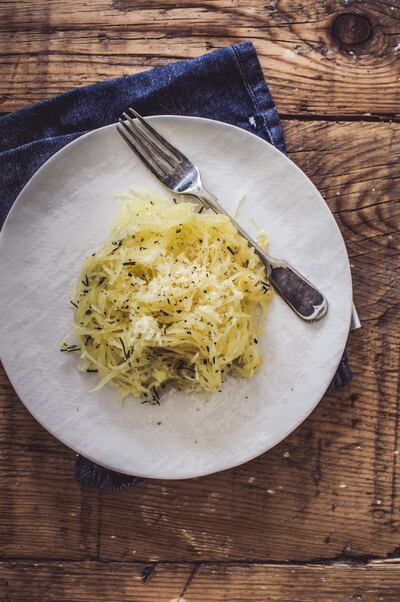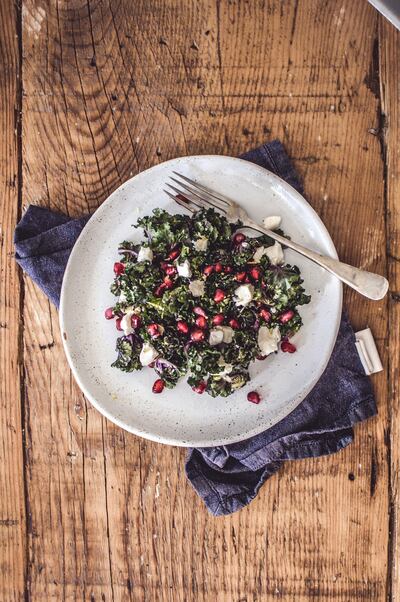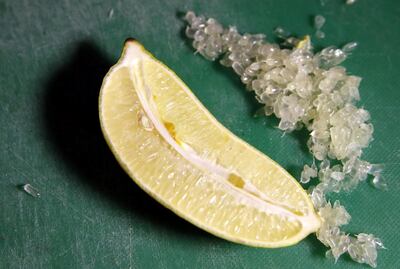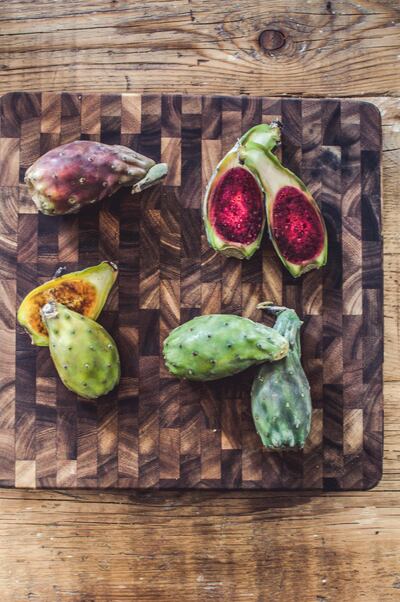Ah, January. A month when our diets are destined to include fruit and vegetables galore. And while there's nothing wrong with the old favourites – apples and tomatoes, carrots and bananas – the next time you go shopping for groceries or place an order online, keep an eye out for some of these more unusual but delicious additions.
Spaghetti squash
What is it?
Sometimes found moonlighting under the alias of vegetable or noodle squash, this yellow-skinned, oval-shaped winter squash doesn't look all that exciting when raw. Once you cook it – whether by steaming, boiling, microwaving or baking – everything changes, and it's suddenly clear where the name comes from. Scrape the flesh gently with a fork and it separates into thin, golden tendrils that resemble strands of spaghetti.
What does it taste like?
With its mild, slightly sweet taste, spaghetti squash doesn’t pack the weightiest of flavour punches. That’s not always a negative, though, and this subtlety means that it matches well with other more assertive partners – think garlicky ragus, rich curries and aromatic tagines.
What can you do with it?
Using spaghetti squash as a low-calorie, low-carbohydrate, gluten-free alternative to pasta is the most obvious choice. Once cooked – we particularly favour oven-roasting for about 45 minutes at 200°C after slicing the squash in half and scooping out the seeds – drizzle the strands with olive oil, season generously with salt and pepper, and top with your favourite pasta sauce or simply scatter with plenty of fresh Parmesan.
As always, it can pay handsomely to get creative. Toss the cooked squash ribbons through a mustardy vinaigrette and serve cold as an accompaniment to roast chicken or fish, or use it in place of noodles when making broth-based soups. You can even mix it with beaten eggs, flour, ricotta and crushed garlic, form into little fritters and fry until crisp and golden.
Kalettes
What are they?
A cross-breed between kale and Brussels sprouts, kalettes resemble baby cabbages, but with delicate, kale-like leaves, and are among the trendiest ingredients you can add to your shopping basket. As well as looking cute, this vegetable is incredibly good for you, providing a notable dose of fibre, folate, and vitamins C and K.
What do they taste like?
The flavour of the kalette is, unsurprisingly, akin to that of sprouts, but without the rather aggressive bitterness that so many of us dislike. Once cooked, the purple stems of these cruciferous bundles take on a pleasant tenderness, with the leaves retaining a nutty crunch.
What can you do with them?
Kalettes can be eaten raw, making them an ideal base for an easy, interesting salad – just the thing for January eating. Whatever salad accompaniments you choose (we like feta with pomegranate seeds and molasses), go against convention and douse the kalette leaves in the dressing well before serving, so they start to soften slightly.
Alternatively, shred the leaves into confetti-like strips and add to a stir-fry, or dot over an almost-finished cheesy frittata, or use in place of basil for a new, healthy take on home-made pesto. Kalettes are also fantastic kept whole and roasted in the oven with plenty of olive oil and garlic, or you could blanch in boiling water for a minute or two, drain well and add to a hot wok or frying pan before drizzling with honey and soy sauce.
Finger limes
What are they?
Known scientifically as Citrus australasica and first grown on the east coast of Australia, gnarled and gherkin-like finger limes may not look like much from the outside, but their thin skin hides treasure. And what treasure it is – a mass of tiny translucent-green jewels, the colour of which changes as the fruit matures. It’s little wonder that these are known as the caviar of the fruit world.
What do they taste like?
As you might expect, lime is the dominant flavour, but there’s certainly a hint of citrusy, aromatic lemon there, too. It’s the feel of this fruit in the mouth that really adds intrigue, though, particularly the way the little pearls explode in the mouth – hence the comparison to caviar.
What can you do with them?
These edible baubles add a fitting final flourish to savoury and sweet dishes alike. For wow factor, stir finger-lime droplets through a thick cheesecake or ice-cream mix and they’ll remain suspended within, or simply arrange over the top of a dessert. Pile on to canapes, use the droplets to add sharpness to seafood dishes – they match well with briny oysters – sprinkle through salads, or squeeze the juice into drinks for a citrus hit.
Cotton candy grapes
What are they?
Cotton candy grapes are exactly what you imagine them to be – grapes that taste rather like candy floss. Despite a name and even a taste that’s suggestive of the artificial, these grapes aren’t genetically modified at all – their sweetness comes as a result of natural breeding, and trial-and-error cross-pollination between two grape species.
What do they taste like?
Sweets in grape form. Which is no surprise, given that cotton candy grapes contain about 12 per cent more sugar than normal table grapes. And the taste really does live up to the name. Take a bite, close your eyes and you could be eating frothy clouds of spun sugar at the fairground. This lingering sweetness is further accentuated by the distinct lack of tartness that often characterises white grapes, and the more discerning tasters among you may even be able to identify a hint of vanilla.
What can you do with them?
If you can resist gobbling these little balls of sweetness straight from the bag or box, it’s worth popping them in the freezer for a couple of hours so that they develop a frosty, sorbet-like texture. You can also experiment with using the sweetness of the grapes as a foil to bolder, tangier ingredients. Add to a cheeseboard heaving with creamy, oozing Brie and crumbling aged blue cheese, and you’ll see what we mean. You can also easily turn them into a fruit compote that has the potential to elevate your morning granola bowl for days to come, and they would also work well served with slow-braised meat. For something a bit different, try drizzling the grapes with olive oil, dousing with black pepper and roasting in the oven.
Prickly pears
What are they?
A type of glochid-covered, pear-shaped cactus fruit, this is also known as Indian or Barbary fig or tuna. As well as being used to treat ailments such as indigestion and muscular pain, prickly pears have been farmed for eating for thousands of years, and both the flesh and nopales (cactus pads) remain a key ingredient in Mexican cooking, in particular.
What do they taste like?
The flavour of prickly pear flesh varies noticeably according to ripeness and operates on something of a traffic light system: green (slightly sweet), orange (sweet) and red (very sweet, syrupy even). The taste is difficult to pin down. It is heady and aromatic with a certain strawberry-watermelon note and a slightly unusual aftertaste.
What can you do with them?
Approach the spine-covered outer layer of the prickly pear with a degree of caution. They may not look like they will cause much damage, but it’s no fun if a tiny prickle or two pierces your skin. Once you’ve dealt with that, you can discard the seeds and eat the fruit as it is. It tastes particularly good served chilled, or blitz it to make prickly pear juice, or use the pulp for jam, adjusting the sweetness according to ripeness. You can also mix the diced flesh with cornflour, sugar and perhaps a handful of diced cooked apples for a tasty pie filling, or combine with chopped tomatoes, red onion, jalapeno peppers and coriander to make salsa.
